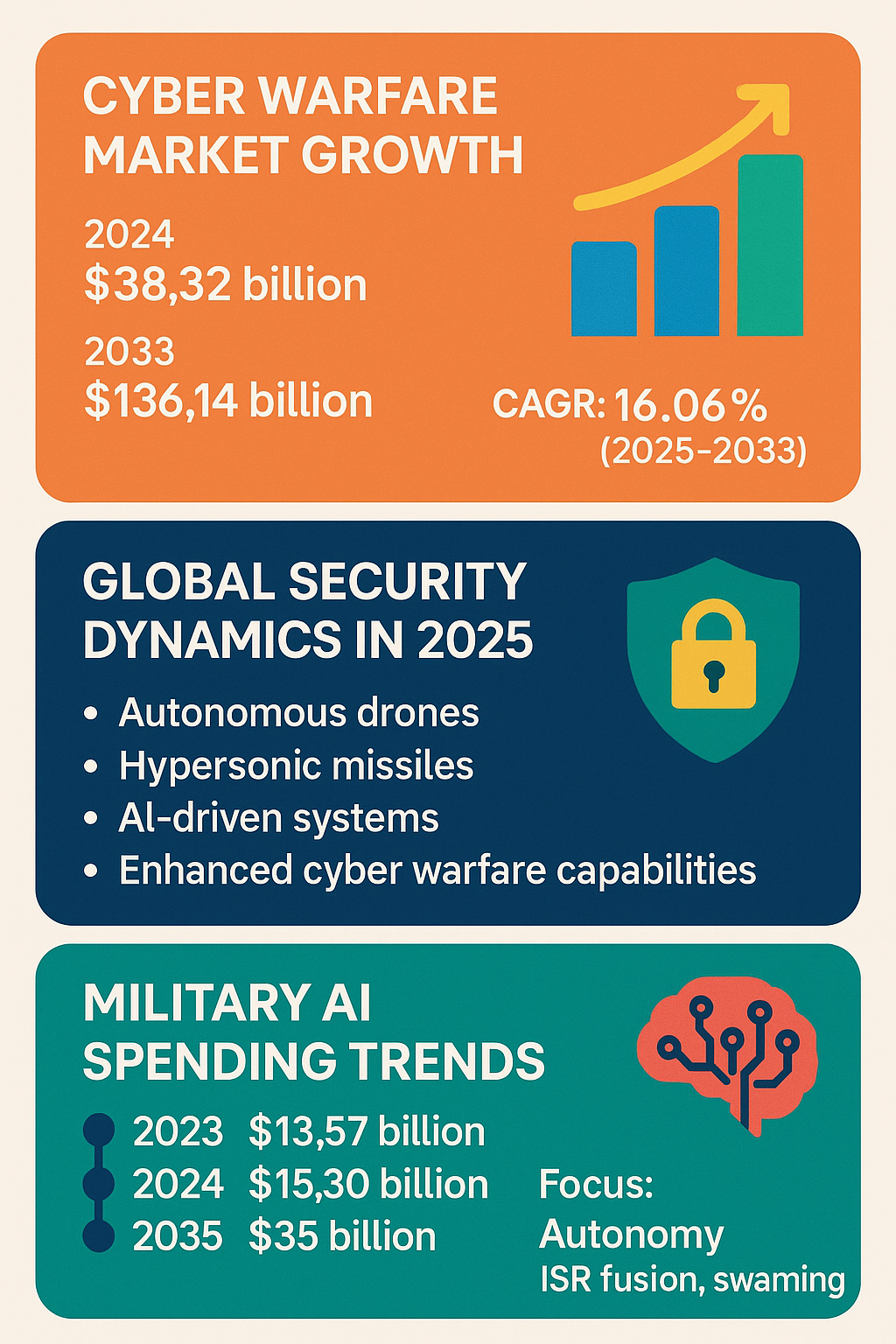Global Scans · Weaponization of Everything · Signal Scanner
The Emergence of Autonomous Drone Swarms: A Weak Signal with Disruptive Potential Across Security and Industry
Autonomous drone swarms represent a subtle but accelerating development poised to reshape multiple sectors in the next five to twenty years. Beyond individual unmanned aerial vehicles (UAVs), the future points toward coordinated, AI-driven swarm systems capable of complex, adaptable operations without direct human control. This weak signal suggests profound changes in military tactics, cybersecurity, industrial logistics, and regulatory landscapes. Understanding the trajectory of drone swarm technologies can prepare stakeholders to navigate disruptions that may currently be underestimated or overlooked.
What's Changing?
Recent reports highlight a rapid evolution of autonomous drones and their integration with artificial intelligence, suggesting a future where swarms—not single drones—dominate operational environments. The deployment of drones by Ukraine in recent conflicts offers an early example of this shift, demonstrating how stealth, surprise, and adaptability can be combined for tactical advantage (Ukraine’s Drone Secrets Exposed).
Military innovation is advancing toward hypersonic missile systems, autonomous drones with AI-driven decision-making, and cyber warfare capabilities that redefine conflict dynamics by 2025 (Weapons 2025). Autonomous drone swarms multiply these effects by coordinating multiple units simultaneously, enhancing battlefield effectiveness beyond human-controlled drones’ capabilities. Such swarms could perform surveillance, targeted strikes, electronic warfare, and logistics support with increasing autonomy.
Aside from military use, the accelerating AI capabilities that empower drone swarms expose growing non-traditional threats in peace and security discourse. Pakistan’s initiative to broaden international cooperation frameworks to include cyber warfare, climate change, and food insecurity signals recognition that such technologies, while beneficial, introduce complex vulnerabilities at national and global levels (Pakistan Assumes UNSC Presidency).
The cybersecurity dimension deepens with AI-assisted drone swarms potentially enabling new offensive and defensive cyber operations. The evolving cyber threat landscape, fuelled by attacks leveraging AI, social engineering, and persistent threats, underscores a future where drone swarms might conduct cyber-physical incursions that could disrupt critical infrastructure or retail systems at scale (Major Cyber Attacks 2025).
Without robust international oversight or ethical AI governance, the rise of intelligent autonomous drones and their collective swarm applications could intensify geopolitical tensions. The so-called AI arms race—potentially involving drone swarms—may escalate conflicts or provoke new security dilemmas, suggesting an urgent need for collaborative control measures (The AI Arms Race).
Why is this Important?
The movement toward autonomous drone swarms signifies more than incremental improvements in UAV technology; it heralds a disruptive inflection point. The complexity and autonomy of drone swarms could:
- Force militaries to rethink tactics, risk assessments, and command/control frameworks.
- Shift cybersecurity paradigms by integrating cyber-physical attack vectors.
- Challenge existing regulatory and legal regimes lacking direction on autonomous weapon systems or commercial drone swarm applications.
- Impact non-military sectors—such as agriculture, delivery logistics, disaster response, and infrastructure inspection—by enabling highly efficient, adaptive, and decentralized operational models.
Industries unprepared for rapid drone swarm adoption may face competitive disadvantages, disruption of supply chains, or regulatory penalties. Governments could struggle to address security risks stemming from uncontrolled or malicious drone swarms operating in civilian airspace.
Implications
Strategic planners should recognize autonomous drone swarms as a multi-layered trend with cascading effects:
- Security Sector: Armed forces should investigate drone swarm countermeasures, AI coordination vulnerabilities, and new doctrines emphasizing decentralized autonomous systems. Defensive systems will require integration of AI-driven detection and mitigation methods.
- Cybersecurity: Organizations must increase resilience against attacks blending physical drone intrusion with cyber exploits. This requires coordination between cybersecurity teams and physical security operators.
- Regulation and Governance: Policymakers need to address legal ambiguity surrounding autonomous swarm deployment. International frameworks could establish norms restricting offensive use while fostering beneficial commercial applications.
- Industrial and Commercial Use: Businesses in logistics, agriculture, energy, and emergency management could leverage autonomous swarms for innovation, but should anticipate infrastructure, privacy, and liability challenges.
Investment in AI ethics and cross-sector collaboration remains crucial. If left unchecked, autonomous drone swarms might accelerate destabilizing arms races or technological divides between nations and industries. Early collective action offers opportunities for governance models balancing innovation with security.
Questions
- How can international cooperation frameworks adapt quickly enough to govern autonomous drone swarm technology responsibly?
- Which industries outside defense stand to gain or lose most from the rise of autonomous, AI-driven drone swarms?
- What are the unintended security vulnerabilities created by integrating autonomous drone swarms with critical infrastructure?
- How might emerging drone swarm technologies reshape the skills and roles of human operators and decision-makers?
- What governance mechanisms can balance innovation incentives with ethical oversight to prevent misuse?
Keywords
autonomous drone swarms; artificial intelligence military; cyber-physical security; AI arms race; autonomous systems regulation; drone logistics
Bibliography
- Weapons 2025: By 2025, autonomous drones, hypersonic missiles, artificial intelligence-driven systems, and cyber warfare capabilities will redefine global security dynamics. Revlon Explore. https://explore.revlon.com/insight/weapons-2025
- Pakistan Assumes UNSC Presidency: Pakistan will likely encourage discussions on non-traditional threats to peace and security - such as cyber warfare, climate change, and food insecurity. Modern Diplomacy. https://moderndiplomacy.eu/2025/07/11/pakistan-assumes-unsc-presidency-a-beacon-of-responsibility-in-troubled-times/
- Ukraine’s Drone Secrets Exposed: Ukraine’s drone deployment strategy could inspire a new era of drone warfare characterized by stealth, surprise, and adaptability. County Local News. https://countylocalnews.com/breaking/2025/06/01/ukraines-drone-secrets-exposed-covert-military-tactics-for-2025/
- Major Cyber Attacks 2025: The evolving cyber threat landscape leverages AI, social engineering, and advanced persistent threat techniques. Breached Company. https://breached.company/major-cyber-attacks-2025-a-comprehensive-analysis-of-the-years-most-devastating-data-breaches-and-ransomware-incidents/
- The AI Arms Race: AI advancements could lead to heightened global tensions, cyber warfare, and security risks without international cooperation and ethical oversight. The Friday Times. https://thefridaytimes.com/09-Apr-2025/the-ai-arms-race-redefining-global-power-and-security
